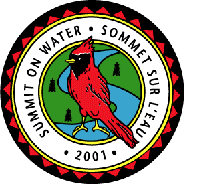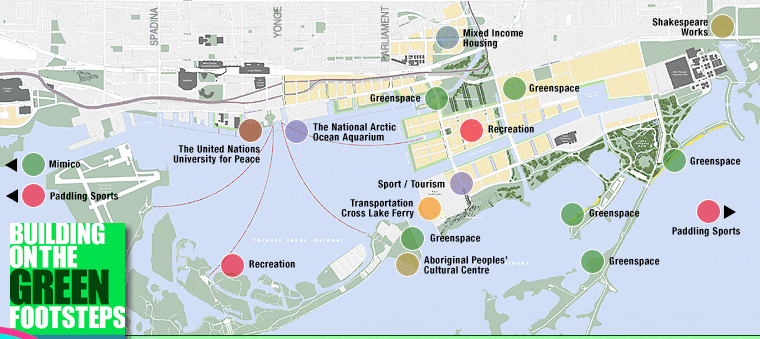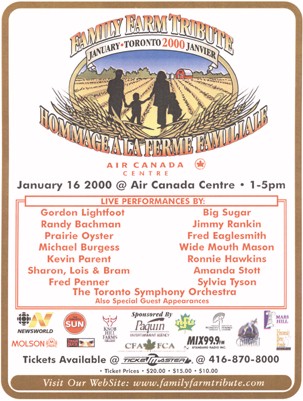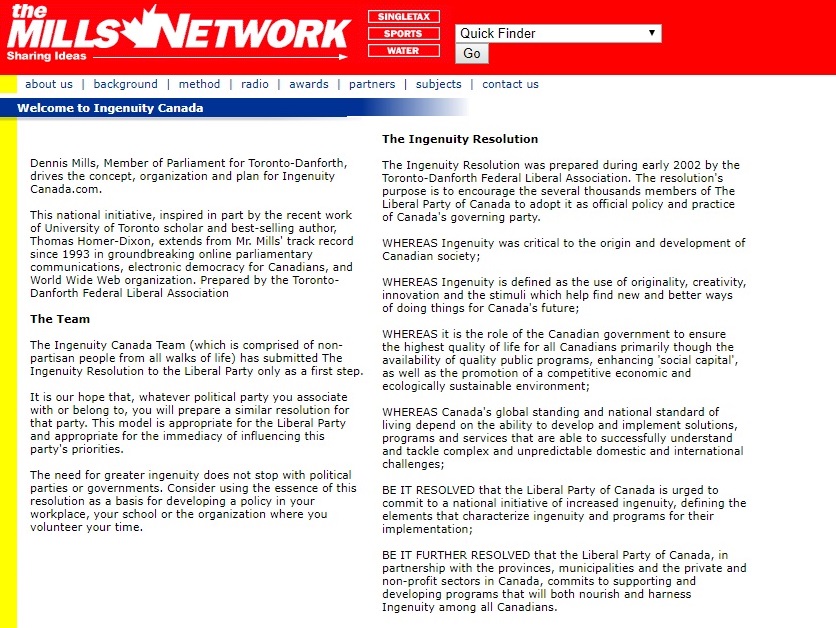Commenced March 2000
The following is the full text of a speech on Canada’s need for a National Food Plan, delivered in the House of Commons March 17, 2000 by Toronto-Danforth MP Dennis Mills
Introductory Remarks to A National Food Plan
“…Mr. Speaker, I should point out that I intended to deliver this speech to a group of restaurant owners in my riding this evening. Instead, that privilege will happen next week.
I felt it was important that we begin this discussion on a National Food Plan in the House of Commons. I would also like to acknowledge my western, urban and rural caucus colleagues, with whom I have been working for the past four months on developing a National Food Plan.
It is important that we begin this discussion here because there is no greater fundamental to a healthy society than a healthy food system. Put another way, Mr. Speaker, if we do not have a healthy food system that works for the benefit of all Canadians, if we do not have a food system that works as well as it could, then we cannot fully achieve our goals in continually working to build and strengthen a healthy society.
Key to our health is the food we eat. And fundamental to the food we eat is the quality, affordability, safety, access and security of that food.
Mr. Speaker, our food system, its production and its distribution, its ownership and its control, have changed dramatically—without public debate, with public knowledge of the importance or the impacts of these changes, and, more importantly, without a clear and well-defined National Food Plan.
Before I move into the details of A National Food Plan, Mr. Speaker, I want to further highlight the natural importance of food to health. One of the organizations that have contributed to developing this Plan is Foodshare of Toronto. Foodshare, Mr. Speaker, understands the importance of a healthy food system to a healthy society. They work each day in making sure that families, seniors and children have access to nutritious, affordable, safe and high quality food, by distributing the Good Food Box to thousands of residents throughout Toronto.
They understand, as do my colleagues and I, that children and seniors, especially, and all Canadians in general, need healthy eating and a nutritious diet as a pre-condition to healthy bodies, healthy minds and overall healthy lifestyles. Of course, a healthy society has tremendous benefits when we talk about the health care system in this country.
Food, Mr. Speaker, is a key determinant of our health as a society. And the production, distribution, ownership and control of our food system is something that my colleagues and I are very excited about presenting today through A National Food Plan.
The source of our food, of course, is the farm. So I must begin by discussing that source and the beleaguered state that Canada’s family farms are in. I will describe the loss of our food processing sector, and I will conclude by outlining key components of a National Food Plan.
A National Food Plan
Worst crisis since the 1930s
The farm income crisis we’ve all heard about is real. Today, net farm income for many farmers is as low as it was during the great Depression. [1] But this isn’t the Depression. The world economy hasn’t collapsed; the stock markets haven’t crashed; and there has not been a prairie-wide drought. Never, during times of economic prosperity have we seen a farm crisis of this magnitude.
Farmers have done everything they can
Some people blame the farmers. In the 1980s and early-90s, whenever farm incomes dropped, experts were ready with advice for farmers: expand, diversify, quit growing wheat, grow high value crops, embrace new technology. The message was: farm incomes are low because farmers are doing something wrong.
Farmers took the experts’ advice. Today, on large farms,
farmers are growing chickpeas and lentils, raising wild boars and alpacas,
using genetically-engineered seeds and high-tech seeding equipment,
value-adding, and marketing. For all this investment and innovation, farmers
have been rewarded with the lowest net farm incomes since the 1930s.
The farm income crisis is hitting farmers all around the world. U.S. farmers are struggling. The U.S. government spent $27 billion [2] last year to support its farmers. Farmers in Australia and Argentina, England and the Philippines have been hammered by record low commodity prices and rising production costs. When one looks at the worldwide nature of this crisis, it is hard to believe that our farmers are to blame, or that our farmers, alone, can solve this problem.
Not working any better for processing sector
We must remember that farmers are not the entire agricultural economy. Farmers are one part of a larger agri-food sector that includes input manufacturers, food processors, meat packers, restaurant owners, and others.
So perhaps the dislocation of farm families has been offset by significant job creation in the food processing sector. After all, when the Crowsnest Pass Freight Rate was discontinued in 1984, and the Crow Benefit in 1995, it was predicted that these changes would lead to rural diversification, increased domestic food processing, and processing jobs. Today, the food processing sector employs fewer Canadians than it did in 1984.[3] The jobs that were predicted have not materialized.
But much more disturbing, is that over the last 15 years
foreign corporations have taken over Canada’s important food processing sector.
From milling to malt, from pasta to beef packing, foreign ownership and control
of our food processing is increasing. Foreign corporations own 79% of Canada’s
flour milling capacity. Just one American corporation, Archer Daniels Midland,
owns approximately 50% of Canada’s milling capacity. Its ownership stake is up
from 30% in 1995 and zero in 1985.
Malt is used to make beer. And Canadian malt plants are 93% foreign owned. Foreign corporations have taken over 90% of our pasta plant capacity. And 74% of our beef packing sector [4] is owned by only two U.S. firms, Cargill and International Beef Packers.
So the global agricultural system is not serving farmers as well as predicted, nor is it serving the Canadian economy and national interests any better.
Not serving consumers
Nor is Canada’s food system serving consumers as well as it
could.
For example, the price of corn has not changed in twenty years, but the price of corn flakes have tripled. Wheat prices haven’t changed either, but bread prices have tripled. [5]
This says something about the efficiency of our farmers,
ladies and gentlemen. Canada’s farmers are so efficient that they can produce
food for the same prices they did 25 years ago. In contrast, processors and
retailers have tripled the prices they charge for their services.
We are often told that bigger is better; that large
companies are more efficient. Maybe we should let small farmers go bankrupt so
that the remaining large farms can supply us with cheaper food. But the
evidence points the other way. It has been the farmers who have held the line
on price increases for 25 years. It might be interesting to see if Kellogg’s
could sell Corn Flakes at 1975 prices or if Safeway or A&P could sell bread
at 1975 prices. It would be interesting to see just how efficient these big
corporations are in that respect.
The bottom line is that farmers are going bankrupt at one end and consumers are paying more, despite a hold on prices from the farmers, at the other.
Human vignette
There is, of course, more to the story than mere dollars and economics; there is also an immense human tragedy. Across Canada, farm families are caught in the gears of what many have come to describe as a malfunctioning global agricultural machine, one that has decimated rural communities, often damages the Canadian economy, and seriously puts into question Canada’s capacity to produce food.
Need a National Food Plan
So Canada’s food system—indeed, the world’s food
system—while working to the benefit of some, is not working to the benefit of
everyone, least of all the family farms. Is this system destroying and
destabilizing key sectors of Canada’s economy? Many experts say so. What is
more certain is that this system is seriously and negatively affecting many of
our communities.
The main reason we are in this position is because Canada
does not have a National Food Plan.
Rather than craft an effective Food Plan, we have been part of the pack: we’ve deregulated, we’ve signed trade agreements, we’ve increased food exports, and we’ve turned agriculture over to “the market.” On a very superficial level, this strategy has been a success: agri-food exports have quadrupled since the mid 1970s.[6] But we should not be fooled by this increase. Farmers have not seen one penny of benefit from these increased exports.
Our free trade, export-expansion policies have given away
Canadian markets and forced farmers to rely, instead, on low-price, volatile
world markets.
Now I know that it isn’t fashionable to talk about serving the domestic market or acting to control and channel trade flows. But when I look at the family farm crisis in this country, the hand-overs of Canada’s food processing sector to foreign multinationals, the failure of that sector to create promised jobs, and the growing disparity between what the farmer gets and the consumer pays, I can only conclude that it is time to abandon what’s fashionable and examine alternatives to our current path.
Components of a National Food Plan
Canada needs a National Food Plan—one that will safeguard the family farm, maintain Canadian ownership of our strategic food processing sector, create jobs, protect food safety, and ensure that farmers receive a fair share of the consumer’s grocery-store dollar. We need a National Food Plan that puts the needs and interests of Canadian farm families, and the urban families that eat the food, right in the forefront of our concerns.
One: who owns the economy
First, we need to act to maintain Canadian control of key
industries. American railway, Burlington Northern Sante Fe, is buying Canadian
National Railway. Canadian Pacific Railway may merge with U.S. carrier Union
Pacific. These are the railways that haul Canadian grain and they are also key
strategic links in the Canadian economy. Canada is about to lose control of its
railways.
We may also soon lose control of our grain companies. A
decade ago, farmers in the west co-operatively owned most of the elevators
there. Once a co-operative, United Grain Growers decided to sell stock on the
stock exchange in 1992 and, six years later, the American conglomerate, Archer
Daniels Midland, stepped in and bought 42% of that stock—giving it effective
control.
Saskatchewan Wheat Pool, Canada’s largest grain company,
created by farmers in 1924, began selling stock in 1995. Though farmers opposed
this move, Sask. Wheat Pool refused to put the change to a vote. Today, Sask.
Pool shares are around five dollars, down from a high of $24 within the last
three years. And it is almost certain that a large U.S. grain company will soon
move in and buy Sask. Pool. Many speculate that the talks have already begun.
And with the merger of Case/IH with New Holland, farmers are
left with only two major farm equipment makers. More important, the merger may
result in the closure of Canada’s last remaining large-tractor plant. It is
outrageous that, with all our land, we may soon cease to make our own tractors.
There are currently six major Canadian grain companies. And
industry analysts predict that mergers and takeovers by U.S. companies will
soon leave only three multinationals.
U.S. and other foreign transnationals are moving in and
buying up even more of the Canadian economy, some say even “looting”
it. Former Conservative Alberta Premier Peter Lougheed recognized that in a
recent speech. Democratic control requires control over one’s economy. And we
are losing that control.
We must take immediate and decisive action, both in regard
to agriculture and the larger Canadian economy. We must act now and immediately
renew the Competition Act. That Act must assess large investments in Canada on
the basis of their effects on Canada’s farmers and Canada’s food production
system. To remain within the parameters of existing international trade
agreements, we must use the tax system to create incentives for broad-based
co-operative ownership of vital food processing companies—co-operative
ownership by Canadian farmers AND consumers. This would ensure that these
companies remain Canadian-owned and controlled.
With regard to our railways, the federal government should examine its options under the existing trade agreements. Canadian railways transport our food, serve remote communities, act as a link in our national defense system, and transport Canadian minerals and forestry products. Surely, when it comes to key strategic infrastructure such as our railways, the Canadian government has options other than merely watching helplessly as these companies pass from Canadian hands.
Two: the farmers’ share
Another component of our National Food Plan would ensure that farmers receive a fair share of the consumers’ grocery store dollar. There are several ways to do this. As a first step, and one that will cost little or nothing, I would propose legislation that requires that every grocery item bear a prominent label, which lists the farmers’ share of the retail price. I believe that Canadians will form a new understanding of the farm income crisis when they are reminded, every day, that the farmer gets only a nickel from the $1.40 loaf of bread and only 14˘ out of a $15 case of beer.[7]
Further, we need to study the farmers’ declining share of the grocery-store dollar, determine the causes of this destructive trend, and act decisively to ensure that increases in the stores translate into increases in farmgate prices, thereby ensuring fairness, equity, and economic sustainability in the overall system.
Three: more market power for farmers:
marketing boards
Any Canadian Food Plan must ensure that farmers have access
to tools which give them proper leverage and a fairer footing in the
marketplace. A lone farmer cannot extract a fair price when bargaining with a
hundred-billion-dollar-a-year food processor. But when farmers work together through
marketing boards and supply management agencies they have that leverage.
Further, this collective strategy is a prudent open-market strategy. Banks, media companies, automakers, airlines, and companies around the world are merging. These companies understand three things: 1) you have to be big to play in the global market; 2) market power is important; and, 3) fewer sellers means fewer competitors, which means higher prices.
These are the principles upon which farmers’ marketing
agencies are based. Those who urge farmers to emulate the open-market had
better have a look at the realities of that market, and realize that by joining
together through marketing boards, farmers are imitating a powerful and prudent
open-market strategy already in place in most other sectors.
In Canada, farmers sell milk, eggs, and poultry through a
supply-management system. Because of this system, these farmers have been
spared from the current farm income crisis. These systems work.
Supply management helps farm families stay on the land and it helps them pass on their farms to sons and daughters. Yet, some oppose the quota system used in supply management. They argue that supply management “prevents entry”, that it prevents new farmers from entering the dairy business, for instance. Those who make that argument seem to imply that without this barrier, the number of Canadian dairy farms would be increasing. Well, the U.S. has no such barrier to entry. And the number of dairy farmers there is not increasing. In fact, the U.S. has lost 45% of their dairy farmers over the last ten years.[8]
Canada’s supply management systems deliver fair and
predictable incomes to farmers and stable supplies of essential products to
consumers at competitive prices.
The Canadian Wheat Board is the single seller of Canadian
wheat and barley around the world. Study after study shows that the Wheat Board
puts extra money into farmers’ pockets. For this reason, farmers overwhelmingly
support the CWB. The CWB is governed by a board of directors democratically
elected by farmers.
Canada’s supply-management systems and the Canadian Wheat
Board can serve as valuable models for other farm products. As part of a
National Food Plan, the federal government should move immediately to work with
farmers in examining the idea of a supply-management system.
The government must then begin to work with farmers to pave the way for new collective marketing agencies. As a final step, it should hold a vote of all affected farmers and proceed according to their democratic will.
Four: more market power for farmers:
collective buying
While farmers need collective leverage when selling their
products, they also need collective leverage when buying their inputs, just as
the current government has done with the new Canadian Wheat Board.
A generation ago, we had a dozen major farm machinery
manufacturers. Today, we have two. Individually, Canada’s 276,000 farm families
have little bargaining power against these giants. And with the declining
number of firms in each sector, competition provides little protection.
Just as farmers and government worked together to form collective selling agencies, farmers and government must now work together to form collective buying agencies.
Five: controlling agri-business market
power
An effective National Food Plan would also control the power
of huge agri-business transnationals.
When a farmer raises pigs, he or she needs to cover
production costs and make a profit. When a typical agri-business transnational
raises hogs in one of its huge barns and ships those hogs to its packing plant,
the price of the hog is irrelevant. If hog prices fall, that transnational
merely makes more money at the packing plant level. The family farmer, however,
goes broke. It is impossible for a farmer to compete with a huge transnational
that owns the packing plants as well as the barns.
Further, when packers own the pigs, farmers lose “price
discovery.” Since pigs move from one division to another of the same
company, and not through public auction, farmers cannot even determine the
“market price.”
Packers should not own pigs or any other livestock. Livestock must be sold through public auctions or public contracts with mandatory price reporting.
Six: Food safety
Our National Food Plan must ensure that food is safe. Canada
enjoys a reputation for producing some of the highest quality food in the
world. But that reputation is threatened by continued cuts to our food
inspection system and by increasing corporate interference in our
health-protection system.
Canada’s National Food Plan must specify that Canadian food is tested, regulated and inspected by independent government inspectors and scientists.
Food Security
In addition to food safety, we need food security. Living in
Canada, surrounded by agricultural land which produces more food than Canadians
need, it is hard for us to imagine that the world may be plunged into a
devastating food shortage.
But let us be perfectly clear on this point. There is no surplus of food. The conventional wisdom that farmers’ prices are low because of oversupply is not true. Today, we have only an 80-day supply of wheat in the world.[9] When we look at corn, oats, and other staple grains, the world supply is less than two months.
I think that when one looks at these low levels of food
stocks, combined with the hunger and starvation in the world, and then one
looks at the low prices and the economic pain Canadian farm families are
facing, I think that one must conclude that the system is ready for serious
revision and improvement.
We need a National Food Plan that will ensure that Canada—and the world—has food security.
Seven: International trade and the WTO
Finally, and perhaps most importantly, Canada’s National
Food Plan must deal honestly with the effects of globalization, increased
trade, and the NAFTA and WTO agreements.
These agreements have not benefitted farmers or the Canadian
economy as a whole as well as predicted. In agriculture, these agreements have
created a huge pool of low-priced produce that moves around the world markets
and sometimes damages food production systems in many nations. By globalizing
food production and distribution, these agreements have increased the power of
transnational grain companies relative to farmers—who must remain local.
Further, these agreements increasingly block actions that
Canadians want, namely to safeguard our food system, food safety, and food
security.
Canadian farmers, consumers and industry representatives must define clear and measurable goals and objectives with respect to its food system. And we must then determine whether the current export-expansion, free-trade system is moving us towards those goals or away from them.
Conclusion
In conclusion, I believe that Canada must lead the world in moving toward a new vision of food production and distribution. To do this, Canada must craft its Food Plan based upon the following principles:
- All Canadians must have secure access to sufficient, nutritious, safe food;
- Canada must work internationally toward global food security;
- Local families must own the land and the farms;
- Farmers must receive a fair and adequate return for their work;
- Farm practices must protect and enhance the natural environment;
- Wealth created in rural areas must foster the security and prosperity of rural communities;
- Canada’s food processing, retailing, and restaurant sectors must be Canadian-owned engines of growth and job creation for Canadians;
- Canada’s trade policies and trade agreements must move us toward, not away from, the preceding goals.
I call on all Canadians to join with me in working toward
these goals, domestically and internationally. I call on all Canadians—rural
and urban—to work with me to create a National Food Plan for Canada.
Thank you.
(End of speech.)
Footnotes
[1] Low income levels: in Saskatchewan, 1999 per-farm realized net income (adjusted for inflation) was projected to be just $1,783. In order to find a level this low, one has to go back to 1938. Worse still, Agriculture and Agri-food Canada has predicted negative realized net farm incomes for Saskatchewan in 2001, 2002, and 2003. The situation is the same of grain, oilseed, specialty crop, and hog farms across Canada. Net farm income is not the same as profit. Profit is calculated after everyone is paid. Net farm income is calculated before any allowance is made for farm family labour and management.
[2] Number courtesy of Canadian Wheat Board.
[3] A Profile of Employment in the Agri-Food Chain, Agriculture and Agri-Food Canada, April 1999
[4] Packer data collected by Jim Bateman for the Manitoba Department of Agricultural Economics. Pasta plant and flour milling data from the Canadian Wheat Board.
[5] Consumer prices from Stats. Can. Catalogue # 62-010
[6] Export and import numbers from Agriculture and Agri-Food Canada: Agri-Food Trade Service
[7] Calculations by NFU
[8] 1989: 202,890 U.S. operations with dairy cattle. 1999: 111,220 operations. USDA.
[9] All stocks/use data from United States Department of Agriculture (USDA).
End of notes.

















